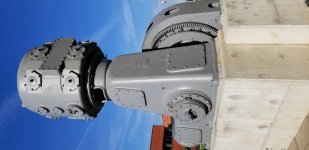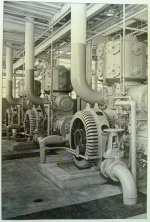What you are seeing is a two-stage air compressor. The horizontal cylinder is missing. The motor is an open-frame synchronous motor, probably turning at something like 300 rpm.
There are many similarities between a slow-speed recip compressor and a steam engine, but there is no mistaking what you have post the photo of: it is an air compressor.
The motor, on the other hand, could be used as a generator. In fact, people have taken slow speed synchronous motors and re-purposed them for use as generators.
Last week, I was at the Mack Brothers Boiler & Sheet Iron Works (see the thread on the 'board about their shop). Jim Hueber, the president of the company, started up a large single cylinder Chicago Pneumatic compressor for us. It dated to 1943 and was belt driven by a higher speed motor. As we looked around the back corner of the boiler shop, I saw what at first glance really looked like a steam engine. It was the original air compressor, also electric motor driven. This older compressor had a mainframe very much like many stationary steam engines used, and the crosshead, connecting rod, and wrist pin all followed steam engine design practice.
The old recip compressors just run along, and are fairly quiet machines. When I worked at the old Rheingold Brewery, in Brooklyn, NY in 1970, they had a number of ammonia compressors with the open synchronous motors. These were vertical compressors built by Vilter or York, and stood somewhere around 15 feet high. The synchronous motors ran at maybe 300 rpm, and the whole compressor room was not overly noisy with the compressors on line.
Once rotary screw type air compressors came on the scene, the use of recip compressors, particularly large ones such as in the posted photos, was doomed. A high speed motor coupled to a rotary screw compressor could produce as much or more compressed air volume (expressed in cubic feet per minute or cfm) in a space that was a fraction of the space occupied by a recip compressor of equivalent rating. A big recip compressor required an extensive foundation to absorb the dynamic impacts from the reciprocating mass, and it required quite a bit more work to erect and service it. A rotary screw compressor is a packaged unit, comes in on its own skid, motor coupled to the air end, unloader system, control box, aftercooler and air/oil separator filter all piped up and ready to go. Make the electrical connections, connect the compressor discharge to the plant air system, and maybe connect cooling water lines for the aftercooler and oil cooler- usually smaller diameter pipe. A rotary screw compressor of 600 cfm, driven by a high speed electric motor comes as a complete skid mounted unit that can sit on a solid floor and go right to work.
A 600 cfm recip compressor is something in the neighborhood of what is in the photos posted in this thread. In the early 1970's, when I began my career as a mechanical engineer on powerplant work, recip compressors of the type shown in the photos posed in this thread were being installed in new powerplants. There would be several such compressors, albeit a bit smaller but of the same type, to make "service air". This was compressed air to run soot blowers, provide atomizing air for the burners during cold startup, work valve actuators, and run air tools for plant maintenance. The service air compressors usually had mechanical lubricators such as McCord or Madison-Kipp multiple feed units. These provided cylinder lubrication, and air compressor cylinder oil had to be kept in stock in addition to the regular lube oil. A "cyclone" type separator was in line on the compressor discharge to try to knock out the cylinder oil and any condensation. Still, some got downstream.
A separate set of the same type of slow speed recip compressors, smaller yet, made "instrument air". These usually had Teflon piston rings by the 1970s. Instrument air had to be oil free and moisture free, so there were usually dessicant driers in this system. Instrument air went to the various control systems such as air operated modulating valves and the two competing manufacturers of air-operated boiler controls: Hagan or Bailey.
In many industrial and powerplants nowadays, it is almost unheard of to find a big recip compressor still in use. To add to the reasons for the demise of these compressors, the old-line compressor builders have merged, globalized, and support for these older recip compressors by the manufacturers (or their successors) is sketchy at best. We recently bought about a 150 cfm Joy rotary screw compressor driven by an International Harvester gasoline engine. It had low hours on it, a tow-behind unit. We paid 650 bucks for a good running unit. In contacting Joy, I discovered Joy is now part of Sullair, and Sullair's answer about a manual for our compressor was: "We no longer support it, buy a current model..." Imagine trying to get parts and support from an OEM on a really old recip compressor. There are aftermarket compressor parts suppliers, but this is mainly for the more widely used recips in the gas pipeline industry. Typically, when an older slow speed recip compressor breaks down nowadays, it is the end for it. It is often less costly to put in a new packaged rotary screw compressor than to repair the old slow speed recip compressor. The rotary screw compressors do scream- speaking from experience as we had them in the powerhouse I retired from. A slow speed recip has a friendly sound and just "perks along". Very different animal for sure.












